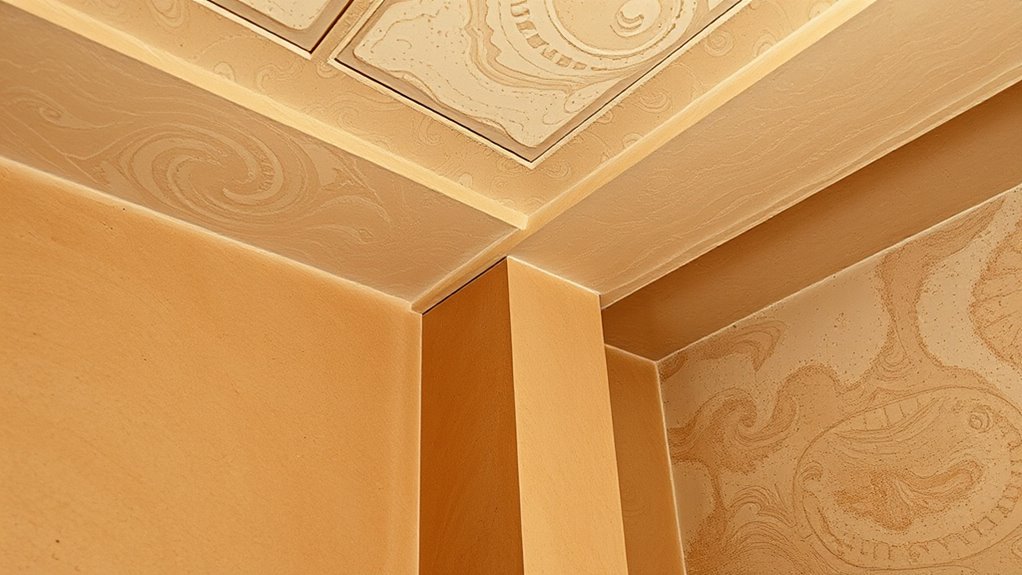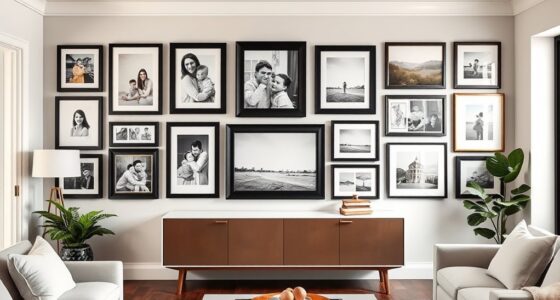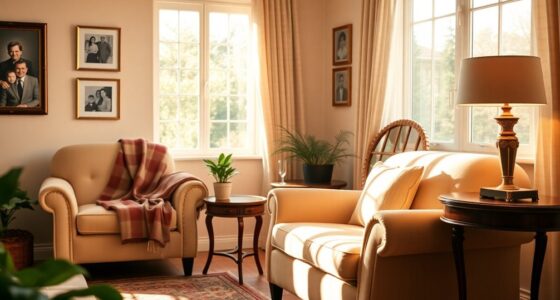Adding textured walls and ceilings instantly brings depth and character to your rooms. You can choose from traditional techniques like plasterwork or modern methods using tools like sponges, brushes, and spray equipment to create unique finishes. These textures hide imperfections and can be customized to match your style, whether bold or subtle. Blending classic and contemporary techniques offers endless possibilities. Keep exploring to discover how textured surfaces can transform your space into something truly special.
Key Takeaways
- Textured walls and ceilings add visual depth and hide imperfections, creating a more inviting and character-rich space.
- Traditional techniques like plasterwork and stucco showcase craftsmanship, blending old-world charm with modern styles.
- Modern tools and materials allow for versatile, customizable textures that can mimic historic finishes or create bold effects.
- Incorporating textured surfaces with sleek furnishings enhances contrast and personalizes interior design.
- Texture elements can be added to existing spaces without full renovations, offering flexible options for aesthetic enhancement.

Textured walls and ceilings can add depth and visual interest to any room, making them a popular choice for homeowners looking to enhance their interior design. You might be surprised to discover how incorporating textures can transform a simple space into something more dynamic and inviting. Historically, textures have played a crucial role in interior design, with traditional techniques used to create patterns and finishes that brought character to walls and ceilings. These historical textures include intricate plasterwork, stucco finishes, and hand-troweled surfaces, which were often crafted by artisans to showcase craftsmanship and detail. Such techniques not only served aesthetic purposes but also offered practical benefits, like hiding imperfections or providing insulation. Modern techniques, including wall surface finishes, allow you to achieve similar effects with greater ease and versatility. You can incorporate textured finishes using tools like sponges, brushes, rollers, or specialized spray equipment, making the process more accessible and less labor-intensive. These modern approaches enable you to replicate or reinterpret historical textures, blending old-world charm with contemporary style. For example, you might choose a textured plaster that mimics the look of aged stucco or a subtle, mottled finish that adds depth without overwhelming the space. These techniques also give you the flexibility to customize textures, from bold and dramatic to soft and understated, depending on your taste and the mood you want to create.
Textured walls and ceilings add character, hiding flaws while enhancing visual interest and depth in any space.
If you’re aiming for a space that feels rich and layered, textured walls and ceilings can be the perfect solution. You can use a combination of historical textures and modern techniques to create a unique backdrop that complements your furniture and decor. For instance, pairing a rough stucco wall with sleek, minimalist furnishings can produce a striking contrast that highlights the textures. Alternatively, a more subtle textured ceiling can add visual interest without overpowering the room’s overall design. With the variety of materials and tools available today, you can experiment with different finishes until you find the perfect look.
Incorporating textured elements doesn’t require a complete overhaul either. You can add a textured accent wall or ceiling to enhance an existing space, making it feel more layered and inviting. Whether you prefer the timeless appeal of traditional textures or want to explore modern techniques, you have endless options to craft a space that feels personally yours. Textured walls and ceilings aren’t just about aesthetics—they’re about creating an environment that reflects your style while adding depth, character, and a touch of history to your home.
Frequently Asked Questions
What Are the Best Lighting Options for Textured Walls?
You should try wall wash lighting to highlight the texture evenly across your walls, creating a soft, glowing effect. Spotlighting is also effective; it directs focused light onto specific textured areas, adding depth and drama. Combining these options can enhance the wall’s character, emphasizing shadows and contours. Use adjustable fixtures to customize the lighting angles, ensuring your textured walls stand out beautifully and add visual interest to your room.
Can Textured Ceilings Improve Acoustics in a Room?
Did you know textured ceilings can reduce noise levels by up to 30%? Yes, they can improve acoustics by enhancing sound absorption, which helps minimize echo and unwanted noise. When you add textured ceilings, you create a surface that diffuses sound waves more effectively than flat surfaces. This makes your room quieter and more comfortable for conversations or relaxation, especially in busy or open spaces.
How Do I Choose the Right Texture Pattern for My Space?
When choosing the right texture pattern for your space, focus on pattern selection and aesthetic considerations. Consider the room’s style—sleek and smooth patterns suit modern spaces, while elaborate textures work well in traditional or rustic settings. Think about how the pattern complements existing decor and lighting. You want a texture that enhances your room’s character without overwhelming it, creating a balanced and inviting atmosphere.
Are There Eco-Friendly Textured Wall and Ceiling Options?
Did you know that eco-friendly materials account for over 20% of the building industry’s market? You can choose textured wall and ceiling options made from sustainable finishes like recycled drywall, cork, or clay plasters. These options not only add character but also reduce your environmental impact. By opting for eco-friendly materials, you create beautiful, textured spaces that are healthier for both your home and the planet.
How Long Does It Take to Install Textured Finishes?
The installation timeline for textured finishes varies, typically taking 1 to 3 days depending on the room size and complexity. You’ll spend time applying the texture and allowing the drying process to complete, which can take 24 to 48 hours. Keep in mind, factors like humidity and temperature can influence drying time. Planning ahead guarantees you accommodate both application and drying, so your textured walls look perfect.
Conclusion
As you step back to admire your textured walls and ceilings, you realize how they subtly transform your space, adding depth and character. It’s almost serendipitous how a simple choice can elevate a room’s ambiance, turning an ordinary area into something truly special. Sometimes, it’s the smallest details—like a beautifully textured surface—that make the biggest impact. In the end, your thoughtfully crafted walls reflect your unique style, proving that beauty truly lies in the details.









